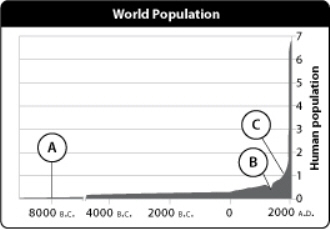The Environment contains________
a. both living and non living things
b. living things only
c. only artificial things
d. nonliving things only
a. both living and non living things
At the start of the Agricultural Revolution about 10,000 years ago, humans began planting crops and domesticating animals.
True
Why do scientists use models? AND why?
Scientists usually use models for objects that they can't see. By creating models it allows for predictions to be made based off their models before experimentation.
Briefly explain the Agricultural and Industrial revolutions and how they affected human population.
The agriculture revolution did not affect the population as much. We saw an increase but at a slower rate. During the industrial revolution the population skyrocketed very quickly due to increase in jobs and resources available.
**See Graph on pg 5 of WB showing trends in population
A person holding a sign during a protest against cutting down trees in a forest would be considered a(n)
a. ecological footprint
b. environmentalist
c. peer reviewer
d. environmental scientist
b. environmentalist
Which of the following are considered part of the environment?
a. forests
b. people
c. buildings
d. all of these
d. all of these
The Agriculture Revolution produced a mass increase in global population due to the amount of people needed for work.
False, Industrial revolution
What is the difference between a independent and dependent variable?
1.Independent variable is the one that will change during the experiment. "change/cause of"
2.The dependent variable changes only when the independent changes...it has to DEPEND on something in order to change. "effect of/ response"
Classify each of the following natural resources as renewable, nonrenewable or "in between": (a) plastic, (b) sunlight, (c) soil.
plastic: non-renewable
Sunlight: renewable
Soil: in between
Which of the following is an example of quantitative data?
a. there are 3 tulips
b. the tulips are red
c. the tulips are prettier than the roses
d. the tulips smell nice
a. there are 3 tulips
Which of the following is NOT an example of a natural resource?
a. coal
b. plastic
c. timber
d. sunlight
b. plastic
The process by which the scientific community examines a paper before its publication is called copyrighting.
False, Peer review
What does it mean to use a resource sustainably?
Using a resource in a way that is constant and that will never harm the chances that the resource won't come back (become non-renewable).
Why do scientists try to control most variables in an experiment or observational study?
To be able to create a baseline for data collection. While watching the similarities of the controlled group, observations can be made about the manipulated/independent variable.
A(n) __________ is a testable idea that attempts to explain a phenomenon or answer a scientific question
hypothesis
Experiments or observational studies in which only one variable is manipulated is described as......
a. observed
b. dependent
c. controlled
d. independant
c. controlled
Anthropocentrism gives value to all living things equally
False, Biocentrism
Sometimes variables are described as "manipulated" and "responding". Which do you think is the alternative name for the independent variable? Explain.
Manipulated variable. Both independent and manipulated are changed throughout the experiment.
What does it mean when science is "self-correcting"?
Over time, with newer technologies, newer evidence comes to light and adds to the evidence already found.
Describe the difference between qualitative and quantitative data.
Quantitative- number of
ex: 10 flowers
Qualitative- description of
ex: blue flowers
Which of the following is the primary difference between a theory and a hypothesis.
a. a theory is tested, a hypothesis is not
b. a theory is broader than a hypothesis, dealing with a wider range of situations and observations
c. a theory is not tested, a hypothesis is
d. a theory only deals with the natural world, a hypothesis does not
b. a theory is broader than a hypothesis, dealing with a wider range of situations and observations.
Ecocentrism is a human centered view of the world in which humans and human welfare are given the highest value.
False, Anthropocentrism
Define the tragedy of the commons
Tragedy of the commons is the event of overusing a renewable resource to the point that it becomes non-renewable. From this, policies are put in place now to try to reduce the likeliness of that happening. Think of the cows in the pasture or lobster fishing examples from the text.
A scientist repeats an experiment ten times. 9/10 times the results support her predictions. She thinks she knows what caused the one trial to produce the unexpected result. Should she report all of the results in her paper, or just the nine that supported her hypothesis? Explain your reasoning.
The scientist should record ALL evidence from experiment, even if it refutes (goes against) hypothesis. This will allow the scientist to comment on what happened and allow anyone conducting the experiment to not make the same mistake. In the end, all evidence should be recorded in experiments.

A. Agriculture revolution
B. Bubonic plague
C. Industrial revolution